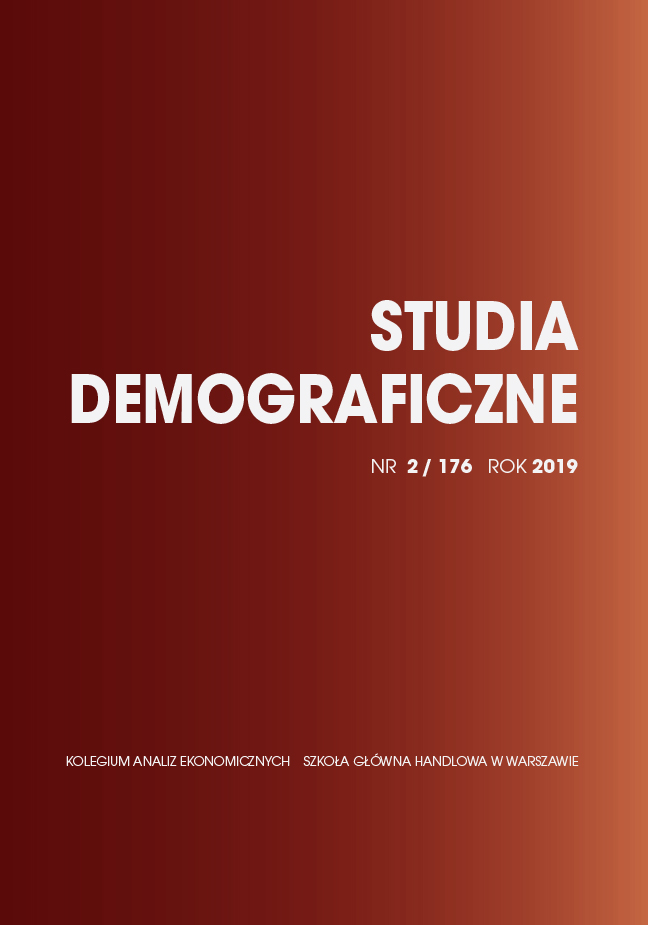Family life as an area of emotional work and investments: an analysis from the perspective of sociology of mental health
Main Article Content
Abstract
The purpose of this paper is to analyse and interpret family life as an area of individuals’ emotional work and investments. The perspective of the above mentioned analysis is designated by the sociology of mental health. Relationships within a family have undeniable influence on the state of people’s mental health. These relationships can be a source of support as well as emotional burden. Families can either compensate for the social stress individuals experience due to processes at the macro level or enhance the emotional tension resulting from social stress. The main method used in this study is meta-analysis of epidemiological and clinical data concerning the mental health of the global (WHO) and Polish population (EZOP-Poland) and my own research – a nationwide, representative survey (N=1,000) carried out in Poland, which was part of a broader theoretical and empirical project devoted to the process of social construction of the categories of mental health, disease and disorder in late modern society. I also refer to my qualitative research including twenty in-depth interviews with psychologists, psychiatrists and psychotherapists who had experience in carrying out family, couples and individual therapy. The research objective was to find out whether and in what way some issues described from the socio-cultural perspective manifest themselves in the form of problems with which people turn to psychotherapists.
The analysis and interpretation of data from the above mentioned sources enable us to put forward a thesis that living within a family entails not necessarily an alternative (either emotional burden or support), but a conjunction (both emotional burden and support). In this context the practical solutions that enable families to protect and strengthen the individual’s mental health should be searched for.
Article Details
References
[2] Charmaz, K. (2009). Teoria ugruntowana. Praktyczny przewodnik po analizie jakościowej. Warszawa: Polish Scientific Publishers PWN.
[3] Durkheim E. (2011). Samobójstwo. Studium z socjologii. Warszawa: Oficyna Naukowa.
[4] Frąckowiak-Sochańska, M. (2019). Konstruowanie kategorii zdrowia, choroby i zaburzenia psychicznego w społeczeństwie późnej nowoczesności. Poznań: Adam Mickiewicz University Press.
[5] Frąckowiak-Sochańska, M. (2010). Rodzinne i społeczno-kulturowe uwarunkowania zaburzeń psychicznych – analiza z perspektywy płci społeczno-kulturowej. Roczniki Socjologii Rodziny, XX, 153–185.
[6] Frąckowiak-Sochańska, M. (2011). Czas wolny kobiet i mężczyzn. Ilość i jakość czasu wolnego jako wymiar nierówności społecznych. In: D. Mroczkowska (Ed.), Status i znaczenie czasu wolnego. Refleksje, dylematy, polemiki. Warszawa: Difin.
[7] Frąckowiak-Sochańska, M. (2016). Psychoterapeuci o klientach i klientkach. Płeć społeczno-kulturowa jako kategoria analizy wzorów funkcjonowania kobiet i mężczyzn w procesie psychoterapii. Rocznik Lubuski, 42 (1), 193–211.
[8] Gałązka-Sobotka, M. (Ed.) (2014). Depresja – analiza kosztów ekonomicznych i społecznych. Warsaw: Lazarski University. Retrieved from: www.instytut.lazarski.pl./izwoz/wydawnictwa/raport-nt-depresji/ (accessed: 19.06.2017).
[9] Giddens, A. (2001). Nowoczesność i tożsamość. „Ja” o społeczeństwo w epoce późnej nowoczesności. Warszawa: Polish Scientific Publishers PWN.
[10] GUS (2015). Budżet czasu ludności 2013. Warszawa: Central Statistical Office.
[11] Hobson C. J., Kamen J., Szostek J., Nethercut C. M., Tiedmann J. W. & Wojnarowicz S. (1998). Stressful Life Events: A Revision and Update of the Social Readjustment Rating Scale, International Journal of Stress Management, 5 (1), 1–23.
[12] Hochschild, A. R. (1979). Emotion work, feeling rules, and social structure. American Journal of Sociology, 85 (3), 551–575. doi:10.1086/227049.
[13] Holmes, T. H., & Rahe, R. H. (1967). The social readjustment rating scale. Journal of Psychosomatic Research, 11 (2), 213–218. http://dx.doi.org/10.1016/0022-3999(67)90010-4.
[14] Jarosz M. (2013). Samobójstwa. Dlaczego teraz?. Warszawa: Polish Scientific Publishers PWN.
[15] Kołodziej-Sarzyńska M., Majewska M., Juchnowicz D. & Karakuła-Juchnowicz H. (2019). Czynniki ryzyka samobójstwa w kontekście teorii integracji społecznej według Émile’a Durkheima, Psychiatria Polska, 53 (4), 865–881.
[16] Kwak, A. (2009). Niedokończony proces indywidualizacji kobiet – czy Ulrich Beck ma rację? In: M. Frąckowiak-Sochańska, S. Królikowska (Eds.), Kobiety w polskiej transformacji 1989–2009. Podsumowania, interpretacje, prognozy. Toruń: Wydawnictwo Adam Marszałek.
[17] Livingston, B. A., Judge, T. A. (2008). Emotional responses to work-family conflict: An examination of gender role orientation among working men and women. Journal of Applied Psychology, 93 (1), 207–216.
[18] McElroy, S. L. (1999). Recognition and treatment of DSM–IV intermittent explosive disorder. Journal of Clinical Psychiatry, 60 (15), 12–16.
[19] Moskalewicz, J., Kiejna, A., Wojtyniak, B. (red.) (2012). Kondycja psychiczna mieszkańców Polski. Raport z badań „Epidemiologia zaburzeń psychiatrycznych i dostęp do psychiatrycznej opieki zdrowotnej – EZOP Polska”. Warszawa: Instytut Psychiatrii i Neurologii.
[20] Schwartz, B. (2013). Paradoks wyboru. Dlaczego więcej oznacza mniej. Warszawa: Polish Scientific Publishers PWN.
[21] Strazdins, L. (2000), Integrating Emotions: Multiple Role Measurement of Emotional Work, Australian Journal of Psychology, 51 (1), 41–50. https://doi.org/10.1080/00049530008255366.
[22] Strazdins, L., Broom, D. H. (2004). Acts of Love (and Work): Gender Imbalance in Emotional Work and Women’s Psychological Distress. Journal of Family Issues, 25 (3), 356–378.
[23] WHO (2013). Fact sheet – mental health. World Health Organization, Regional Committee for Europe – 63 rd session Copenhagen. Retrieved from: www.http://www.euro.who.int/__data/assets/pdf_file/0004/215275/RC63‑Fact-sheet-MNH-Eng.pdf?ua=1 (accessed: 10.05.2017).
[24] WHO (2014). Health for the world’s adolescents. Geneva: World Health Organization. Retrieved from: http://www.who.int/mediacentre/news/releases/2014/focus-adolescent-health/en/ (accessed: 30.09.2014).
[25] WHO (2016). ICD-10, Version: 2016. Retrieved from: https://icd.who.int/browse10/2016/en#/F30 (accessed: 14.07.2019).
[26] World Mental Health, without date, The World Mental Health Survey Initiative. Retrieved from: https://www.hcp.med.harvard.edu/wmh/ (accessed: 11.07.2019).
